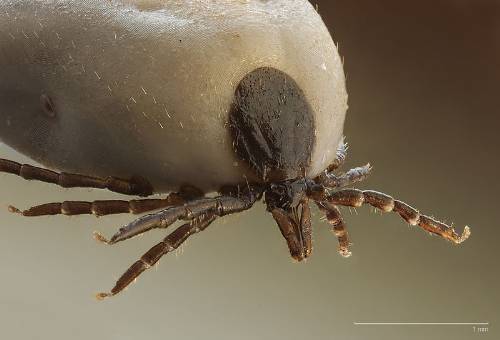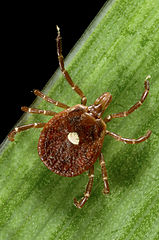Ticks (Order Ixodida)
Online Biology Dictionary
|
|

|
|
A sheep tick (Ixodes ricinus), swollen after a blood meal. Image: Richard Bartz. |

|
|
Lone Star Tick (Amblyomma americanum |
Ticks are arthropods of the arachnid order Ixodida (/ix-AWD-də-dah/). Like mites and spiders, they have bodies that have two main segments: an anterior portion (the capitulum or gnathosoma) composed of the head and mouth parts, and a posterior portion (idiosoma) that bears the legs and contains the digestive tract and reproductive organs. The presence of four pairs of jointed legs places ticks in the Phylum Arthropoda, and the Class Arachnida.
Ticks are hematophagous and attach themselves to animals to obtain their blood meals. Most ticks feed on warm-blooded animals, but some types attach themselves to amphibians and reptiles. Ticks go through a series of larval stages, the number depending on the type of tick in question. Each stage requires a separate blood meal.
Many ticks are vectors of disease. For example, the Lone Star Tick (see photo), found in the eastern and south-central U.S., can transmit disease agents affecting humans, dogs, goats, and white-tailed deer. Representatives from all three of its life stages aggressively bite people in the southern U.S. Lone star ticks transmit Ehrlichia chaffeensis and Ehrlichia chaffeensis, both of which cause disease. Borrelia lonestari, a pathogen associated with “Southern tick-associated associated rash illness” (STARI), also infects lone star ticks. Research suggests that up to 10% of the lone star ticks in an endemic area can be infected with any one of these pathogens. The white dot, or “lone star,” identifies the pictured individual as an adult female.
The scutum, which covers almost the entire dorsal abdomen (see unswollen tick, lower figure above), does not expand, even though a tick swells to an enormous size while ingesting the blood meal it extracts from its host. Thus, in sheep tick (upper figure above), the dark brown scutum, which previously covered much of the dorsum appears small in proportion to the now gigantic size of the bloated parasite.